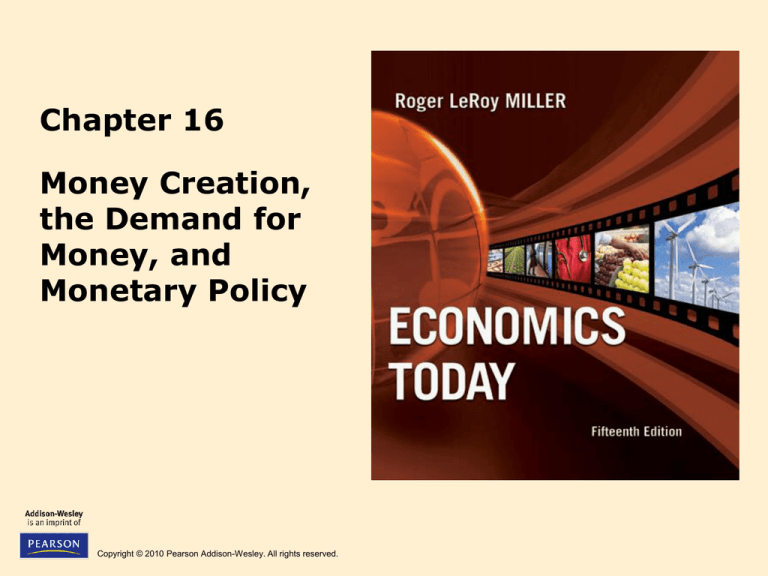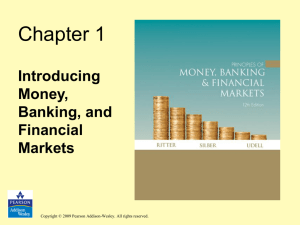
Chapter 16
Money Creation,
the Demand for
Money, and
Monetary Policy
Copyright © 2010 Pearson Addison-Wesley. All rights reserved.
Banks and Money
• As early as 1000 B.C., uncoined gold and
silver were being used for money in
Mesopotamia.
• Later, goldsmiths started issuing paper
notes indicating that the bearers held gold
or silver of given weights and on deposit
with the goldsmith.
• These notes could be exchanged for goods
and were the first paper currency.
16-2
Copyright © 2010 Pearson Addison-Wesley. All rights reserved.
Banks and Money (cont’d)
• Reserves
– deposits held by Federal Reserve + the bank’s
vault cash
• Fractional Reserve Banking
– A system in which depository
institutions hold reserves that are
less than the amount of deposits
• Originated when goldsmiths issued
notes that exceeded the value of
gold and silver on hand
16-3
Copyright © 2010 Pearson Addison-Wesley. All rights reserved.
Banks and Money (cont’d)
• Required Reserve Ratio
– The percentage of total transactions deposits
that the Fed requires depository institutions to
hold in the form of vault cash or deposits with
the Fed
Required reserves = Transactions deposits Required reserve ratio
16-4
Copyright © 2010 Pearson Addison-Wesley. All rights reserved.
Banks and Money (cont’d)
• Excess Reserves
– The difference between actual reserves and
required reserves
Excess reserves = Actual reserves – Required reserves
16-5
Copyright © 2010 Pearson Addison-Wesley. All rights reserved.
The Relationship Between Legal
Reserves and Total Deposits
• Balance Sheet
– Statements of assets (what is owned) and
liabilities (what is owed)
• How a single bank reacts to an increase in
reserves
– We will examine the balance sheet of a single
bank.
16-6
Copyright © 2010 Pearson Addison-Wesley. All rights reserved.
Balance Sheet 16-1 Typical Bank
Reserve Ratio = 10%
Now: What if someone makes a deposit of $100,000 in Typical Bank?
16-7
Copyright © 2010 Pearson Addison-Wesley. All rights reserved.
Balance Sheet 16-3 Typical Bank
Typical Bank lends $990,000………
16-8
Copyright © 2010 Pearson Addison-Wesley. All rights reserved.
The Relationship Between Total
Reserves and Total Deposits (cont'd)
• What do you think?
– Did this loan expand the money supply?
16-9
Copyright © 2010 Pearson Addison-Wesley. All rights reserved.
Money Expansion by the Banking
System (cont'd)
$100,000
90,000
81,000
72,900
New Deposit
Loan by Bank 1
Loan by Bank 2
Loan by Bank 3
$343,900
Total
What do you think?
• Could Banks 4, 5, 6, etc.
create even more money?
• How much can be created?
16-10
Copyright © 2010 Pearson Addison-Wesley. All rights reserved.
Table 16-1 Maximum Money Creation
with 10 Percent Required Reserves
16-11
Copyright © 2010 Pearson Addison-Wesley. All rights reserved.
The Money Multiplier (cont'd)
1
Potential money multiplier =
Required reserve ratio
Actual change
in the money
supply
=
Actual money
multiplier
Change in
total reserves
16-12
Copyright © 2010 Pearson Addison-Wesley. All rights reserved.
The Money Multiplier (cont'd)
• Example
– Fed buys $100,000 of government securities
– Reserve ratio = 10%
Potential change
1
in the money = $100,000
= $1,000,000
x
.10
supply
16-13
Copyright © 2010 Pearson Addison-Wesley. All rights reserved.
Monetary Policy
Ways in Which the Federal
Reserve Changes the
Money Supply
•
Open market operations
•
Reserve requirement
•
Discount rate
•
Hint: Monetary policy
involves the money supply
and interest rates
16-14
Copyright © 2010 Pearson Addison-Wesley. All rights reserved.
Money Expansion by the Banking
System (cont'd)
• The Federal Open Market Committee
(FOMC)
– Can instruct the New York Federal Reserve Bank
trading desk to buy or sell bonds
• Open Market Operations
– The purchase and sale of existing
U.S. government securities (such
as bonds) in the open private
market by the Federal Reserve
System
16-15
Copyright © 2010 Pearson Addison-Wesley. All rights reserved.
The Money Multiplier (cont'd)
• Discount Rate
– The interest rate that the
Federal Reserve charges for
reserves it lends to
depository institutions
– Increasing (decreasing) the
discount rate increases
(decreases) the cost of
borrowed funds for
depository institutions that
borrow reserves.
16-16
Copyright © 2010 Pearson Addison-Wesley. All rights reserved.
The Money Multiplier (cont’d)
• Changes in the reserve requirements
– An increase (decrease) in the required reserve
ratio
• Makes it more (less) expensive for banks to meet
reserve requirements
• Reduces (expands) bank lending
16-17
Copyright © 2010 Pearson Addison-Wesley. All rights reserved.
Reserve Ratios
16-18
Copyright © 2010 Pearson Addison-Wesley. All rights reserved.
Why is the money supply
important?
• There are links between changes in the money supply and
changes in GDP (short run) and the rate of inflation (long run).
16-19
Copyright © 2010 Pearson Addison-Wesley. All rights reserved.
Myth #16: As for money, the more
the better
• The more money we have, other things
being equal, the more you will spend only in
dollar terms (not more in quantity) -inflation
16-20
Copyright © 2010 Pearson Addison-Wesley. All rights reserved.








